Chapter 4
Basic Editing

Introduction
Editing is where the spark of creativity first lights. Editing decides which portion of each clip to show and where it goes in the timeline. Trimming adjusts where two clips touch, called the edit point. Trimming is critically important to storytelling because it adjusts how smoothly one shot flows into the next. Often, you’ll spend more time trimming than editing, even for simple projects.
In this chapter, we—finally!—move into actual editing. There’s so much to cover that we’ll divide editing and trimming into two parts: basic techniques in this chapter and advanced techniques in the next.
Definitions for This Chapter
Editing decides clip order and duration. Trimming adjusts where two clips touch.
Editing. Editing decides what clips to use, their order, and duration.
Trimming. Trimming adjusts where two clips touch.
Through edit. This is a cut (edit) in a clip where nothing was removed on either side.
Camera. The camera represents the eye of the audience. Every time you change the shot, you move the audience to a new place. Treat the audience gently, and be careful not to disorient them.
Primary Storyline (aka magnetic timeline). This is the black bar in the middle of the timeline. Designed for speed and to minimize errors, it’s where you put the principal clip for each scene.
Layer. Other NLEs call these tracks. Apple prefers the term layers. Layers are horizonal levels that hold clips above or below the Primary Storyline. There is no limit to the number of layers in Final Cut.
Connected clip. This is a clip on a higher (or lower) layer that “connects to” a clip on the Primary Storyline. Connected video clips go above the Primary Storyline, while connected audio clips go below it. Connected clips are always rendered to match the project settings.
Storyline. This is a group of connected clips on a higher (or lower) layer that are treated as a single clip. It can hold audio or video but can’t contain clips on multiple layers.
B-roll. This is an old film term describing video clips placed on a higher layer to illustrate what the clip in the Primary Storyline is discussing.
Downstream (upstream): Timelines are often described as water flowing from the beginning (left) to the end (right). Downstream refers to all clips from the playhead (skimmer) to the right. Upstream refers to all clips from the playhead (skimmer) to the left.
Snapping. When enabled, this option snaps the playhead (or skimmer) to edit points and markers. When snapped to an edit point, the playhead (skimmer) is always parked on the In.
In. This is where the playback of a clip starts, which is most often not the start of the clip.
Out. This is where the playback of a clip ends, which is most often not the end of the clip.
Range. This is the part of a clip, or timeline, defined by an In and an Out.
Handles. This is extra audio and video before the In and/or after the Out used for trimming and transitions.
Edit point. This is where two clips touch in the timeline. An edit point has three “sides” or edges: the In, the Out, and both the In and the Out.
Ripple trim. This adjusts one side of an edit point, the In or the Out. Ripple trims always alter the duration of a project.
Roll trim. This adjusts both sides of an edit point at the same time. Roll trims never alter the duration of a project.
Timeline element. This is shorthand for things in the timeline: clips, titles, generators.
Mark Clips
Marking clips begins the editing process. This determines the start and end of each clip when edited into the timeline.
192 Playback Shortcuts
There are a variety of ways to play clips.
The easiest way to play any clip is to press the spacebar.
Shift-spacebar. Plays a clip in reverse.
J. Plays a clip in reverse.
J-J. Plays a clip in reverse at double-speed.
J-J-J. Plays a clip in reverse at 4X speed.
L. Plays a clip forward.
L-L. Plays a clip forward at double-speed.
L-L-L. Plays a clip forward at 4X speed.
J-K. Plays a clip in reverse in slow motion.
L-K. Plays a clip forward in slow motion.
Here are more playback shortcuts that work in the timeline:
Skim clips with the mouse, trackpad, or trackball, as well as play clips using the keyboard.
/. Plays the selection.
Shift+?. Using the durations set in Preferences > Playback, shifts the playhead from its current location back to the pre-roll duration, plays through the edit, then stops at the end of the post-roll duration. It then returns the playhead to its original position. This is often used to review continuity through an edit point.
Shift+Option+I. Plays from the beginning of the Browser clip or timeline to the end.
Shift+Option+O. Plays from the current playhead (skimmer) position to the end of the selected region or timeline.
Shift+Cmd+F. Displays and plays the timeline full screen. (Press Esc to exit.)
Cmd+L. Toggles playback looping on or off. When enabled, this jumps the playhead from the end of a clip or selected range back to the beginning. You won’t see the effect of this shortcut until playback resumes.
193 Snapping—the Secret to Precision
This “snaps” the playhead (skimmer) to an In or a marker.
Snapping works even if the Position tool is active.
You enable snapping (shortcut: N), which is off by default, by clicking the Snapping icon in the top-right corner of the timeline (see 4 in FIGURE 4.1). When enabled, it “snaps” the playhead, or skimmer, to the In at any edit point, the In or Out of any marked range, or the location of any marker.
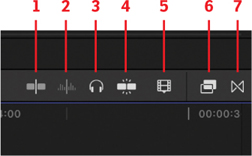
FIGURE 4.1 Click the Snapping icon (4) in the top-right corner of the timeline to enable snapping. (See Tip 96, Timeline Control Icons, for definitions of the rest of these controls.)
Snapping works in both the Browser and the timeline. It ensures that the playhead is correctly positioned at the In of a timeline clip when doing an insert or overwrite edit.
194 Marking a Clip Sets the In and Out
Marking reduces the time you spend trimming.
Note
Make selections “on the fly” while playing Browser clips by pressing I or O at the desired point during playback.
To mark a clip means to set an In and/or an Out. This marked area is called a range. Clips are marked in the Browser. Move the playhead, or skimmer, where you want the clip playback to start, and press I. Then, move the playhead (skimmer) where you want playback to end, and press O. If no In is set, FCP defaults to the start of the clip. If no Out is set, FCP defaults to the end of the clip.
Final Cut indicates this area, called a range, in the Browser by surrounding it with a gold box; see FIGURE 4.2. That gold box does not indicate the image you are editing; rather, it indicates the duration of the clip you are editing into the timeline.

FIGURE 4.2 A selected range (top) for a Browser clip. The numbers in the box indicate its duration.
You can also select a range in a Browser clip by dragging across the clip with the Select (arrow) or Range tools. If the clip extends to a second row, either drag across the break or extend it by Shift-clicking. Option-drag to replace an existing range with a new range.
Here are some other useful shortcuts:
X. Select the entire clip.
Option+X. Remove the marked range.
Shift+I. Jump the playhead to the In.
Shift+O. Jump the playhead to the Out.
Click-drag one of the yellow vertical lines to adjust the In or Out.
195 Select Multiple Ranges in One Clip
You don’t need to create just one range at a time.
A range is that part of a clip with an In and/or an Out. Although it is normal to use multiple ranges from the same clip, Final Cut has a unique feature: You can select more than one range in a clip at the same time, provided the ranges don’t overlap.
To create a single range, drag the playhead, or skimmer, across a Browser clip.
To create multiple ranges, create the first range either using the Range tool or entering an In and Out. Then Cmd-drag to select additional ranges in the same clip; see FIGURE 4.3.
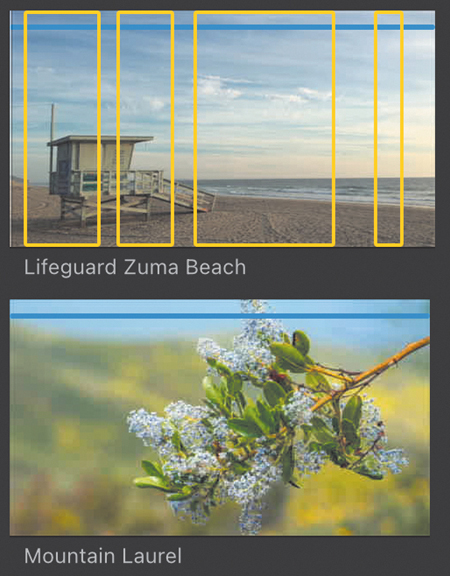
FIGURE 4.3 (top) Multiple selected ranges in a single clip. The lower clip has no ranges in it.
To select a single range, click a range.
To select multiple ranges in one clip or across several clips, Cmd-click.
To deselect a selected range, Cmd-click it.
To delete a selected range, Option-click it.
196 Browser Clip Icons
Here’s what these strange clip icons mean.
Once you mark a clip, new icons appear in the corners of clips; see FIGURE 4.4. These frame markers are visible in the Browser and Viewer when the playhead (skimmer) lands on the appropriate frame. None of these icons export.

FIGURE 4.4 The playhead is parked on the In (top) or Out (bottom) of a Browser clip.

The playhead is parked on the In (top) or Out (bottom) of a timeline clip.
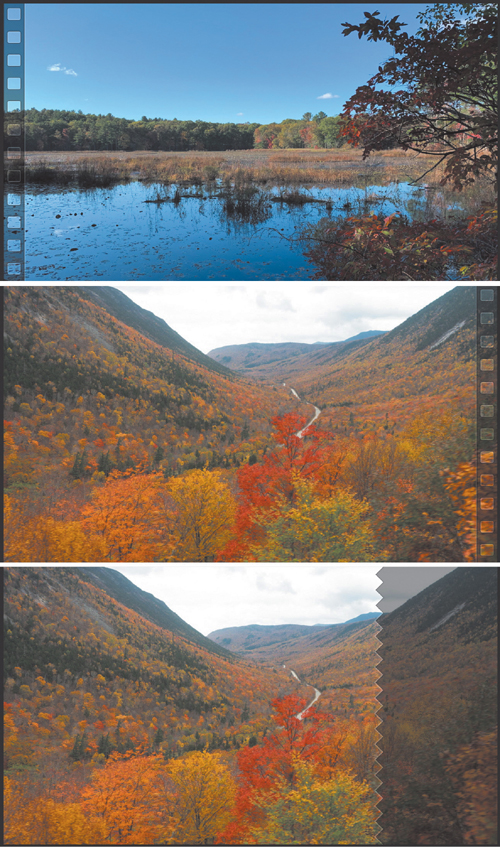
The playhead is parked on the first frame of the timeline (top), the last frame of the timeline (middle), or past the end of the timeline (bottom).
Here’s what they mean.
Edit Clips
Once clips are marked, editing determines their order in the timeline.
197 The Magnetic Timeline Is Not Evil!
It’s incredibly helpful—once you learn what it does.
Nothing has been so vilified in Final Cut Pro as the magnetic timeline. But once you understand it, it becomes an amazing tool. Prior to Final Cut Pro (X), a big problem in all video editing systems was very quick flashes of black caused by one to two frame gaps in the timeline. These were impossible to see unless you were zoomed way in to the timeline. These were so bothersome that Final Cut Pro 7 even added a special shortcut to find and remove these gaps.
The magnetic timeline is designed to prevent problems and speed editing.
Final Cut Pro (X) fixed that. When clips were edited into the Primary Storyline, which is the black channel in the middle of the timeline, they would automatically shift position so that edit points always touched. This made editing faster because you no longer needed to perfectly position the playhead or skimmer before making the edit.
Clips edited to higher layers (Apple prefers not to call these tracks) always connect to clips in the Primary Storyline. This speeds editing because if you move, say, a talking head clip in the Primary Storyline, all the B-roll and sound effects clips connected to it move in sync with it.
These two operational changes make editing a lot faster and more secure than on any other NLE. However, as you’ll learn in this chapter, there are many techniques that temporarily suspend this magnetic behavior to create exactly the edits you have in mind.
198 Final Cut Pro Supports Four Edit Options
Append, insert, overwrite, and connected.
Final Cut supports four types of edits: append, insert, overwrite, and connected. These four edits determine how and where clips are edited from the Browser into the timeline.
The four edit options in Final Cut Pro are append, insert, overwrite, and connected.
Append (shortcut: E). This places the selected Browser clip, or clips, into the Primary Storyline at the end of all existing clips in the timeline. It ignores the position of the playhead or skimmer. Append edits do not alter, move, or replace any existing clips.
Insert (shortcut: W). This inserts the selected Browser clip, or clips, into the Primary Storyline at the position of the playhead (skimmer) and pushes all clips to the right of the edit point downstream for the duration of the inserted clip. Insert edits do not alter or replace any existing clips.
Overwrite (shortcut: D). This edits the selected Browser clip, or clips, into the Primary Storyline at the position of the playhead (skimmer) and replaces whatever clips are currently in the Primary Storyline for the duration of the incoming clip. Overwrite edits do not move any existing clips.
Connected (shortcut: Q). This places the selected Browser clip, or clips, onto the next highest layer above (for video) or below (for audio) the Primary Storyline such that no existing clips are replaced, overwritten, or moved.
199 Editing Icons, Tools, and Shortcuts
Yes, you can drag a clip, but these shortcuts are faster!
When it comes time to move a shot from the Browser into the timeline, you have three choices:
Drag it.
Use an editing icon/button.
Use a keyboard shortcut.
Dragging a clip is easy. Keyboard shortcuts are much faster.
Dragging works. It’s easy, but it isn’t very precise, and it isn’t very fast.
FIGURE 4.5 illustrates the five editing icons (yup, one is hidden). The numbers for the icons correspond with the callout numbers in FIGURE 4.5:
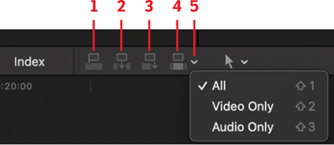
FIGURE 4.5 Editing icons: 1. Connected, 2. Insert, 3. Append, 4. Overwrite, 5. Menu.
Connected edit
Insert edit
Append edit
Overwrite edit
Chevron menu to select between editing audio only, video only, or both
The chevron menu remains set until you change it. It doesn’t automatically reset.
Although these editing icons are helpful to editors who are new to the program, my preference is shortcuts. I’m a keyboard junkie. These shortcuts mean I can keep one hand on the mouse and the other on the keyboard while editing.
E. Append edit.
W. Insert edit.
D. Overwrite edit.
Q. Connected edit.
Shift+1. Edit clip audio and video.
Shift+2. Edit clip audio only.
Shift+3. Edit clip video only.
200 What’s a Connected Clip?
A connected clip is any clip not in the Primary Storyline.
Either a clip is in the Primary Storyline or it is connected to it. These connections are visible as light blue dots on top of the Primary Storyline clip representing the In of the connected clip. There is no limit to the number of clips connected to a Primary Storyline clip, nor the number of layers in a project.
A clip either is in the Primary Storyline or is connected to it.
The big advantage to connected clips is that they always stay in sync with the Primary Storyline clip. This means that if you have B-roll, sound effects, or even a music cue connected to a Primary Storyline clip, then decide that the Primary Storyline clip would work better elsewhere in the project, simply move the Primary Storyline clip. All the clips connected to it tag along without losing sync.
201 What’s a Clip Connection?
All clips are connected vertically, but you can move the connection.
All clips not on the Primary Storyline are connected to the Primary Storyline clip; see FIGURE 4.6. These clips are called, not surprisingly, connected clips. This connection means that if the Primary Storyline clip moves, all clips attached to it move as well.

FIGURE 4.6 Clips on layers always connect to the clip on the Primary Storyline.
Those connections are indicated by light blue dots at the top of the Primary Storyline clip unless the connected clip is selected, in which case you see a faint blue line. By default, connections are set to the In of the connected clip.
Most of the time, this connection location is fine. Sometimes, though, you need to move the connection to a different Primary Storyline clip. To do so, press and hold Option+Command then click anywhere inside the connected clip. The connection moves to wherever you click.
202 What’s a Storyline?
A storyline is a collection of connected clips and transitions.
Apple has evolved the storyline function since FCP was first released. Now, a storyline is a collection of clips and transitions that are treated as a single entity; see FIGURE 4.7. A storyline can contain audio or video clips.
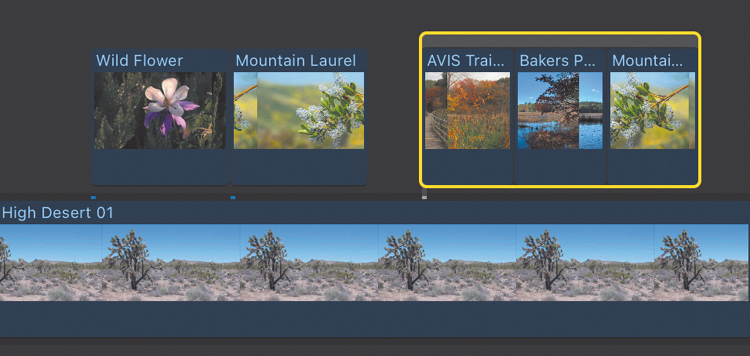
FIGURE 4.7 Two separate connected clips (left) and a connected storyline (right). The connected storyline has only one connection and a gray bar on top. The separate clips each have a timeline connection and no bar on top.
A connected storyline treats a group of clips as though they were on the Primary Storyline:
Clip edges touch.
Spaces between clips are not allowed, unless inserted as a gap clip.
Dragging one clip shuffles other clips.
Transitions are supported.
The most common use of storylines is when transitions are added; see Chapter 7, “Transitions & Titles.” However, a connected storyline is used whenever you want to group one or more clips. Storylines can group clips only on the same layer. (To group clips on multiple layers, use a Compound clip. See Tip 245, What’s a Compound Clip?)
To create a storyline, select the clips you want to group and choose Clip > Create Storyline (shortcut: Cmd+G). If there’s a gap between clips, Final Cut adds a gap clip between them.
To break apart an existing storyline, choose Clip > Break apart clip items (shortcut: Shift+Cmd+G).
To move a storyline, drag it by the top bar.
To rearrange or trim a clip inside a storyline, select it and drag the clip, just like a clip in the Primary Storyline.
To delete a clip from inside a storyline, select it and press Delete.
You’ll find yourself using storylines the most when adding transitions.
203 Move Primary Storyline Clips
Move the clip; leave the connections. This is a grave decision.
Usually, if you delete a Primary Storyline clip, all the clips connected to it are deleted as well. (They aren’t actually deleted, but they are removed from the timeline.) However, if you have a clip connected to a Primary Storyline clip, it’s possible to move or delete the Primary Storyline clip without changing the position of the connected clip around it.
The trick is to press and hold the grave (`) accent key on your keyboard before you do anything. (This is the same key as tilde [~], just below Esc on U.S. keyboards.) You’ll see an odd little orange globe icon next to the cursor; see FIGURE 4.8. You can now move or remove the Primary Storyline clip from under the connected clip without the connected clips moving! All the clips to the right then move left to fill the gap.
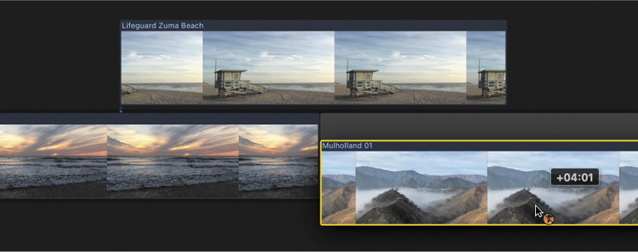
FIGURE 4.8 Pressing the grave (`) key while dragging moves a Primary Storyline clip without moving the clips attached to it.
204 Constrain Clip Movement
Press and hold Shift while dragging a clip.
Moving clips by dragging them sideways in the timeline adjusts the timing of your story. However, when you drag a clip vertically from one layer to another, the one thing you don’t want is for the clip to change its horizontal position, because that changes its timing.
So here’s the secret: Press and hold the Shift key while dragging a clip up or down in the timeline to prevent it from shifting from side to side. (See, a pun!)
205 Change Clip Durations
If you know what you need, this is faster than dragging.
Most of the time, we change the duration of a clip by dragging an edge; this is called trimming. However, there is a faster way, provided you know the duration you need. Good uses for this are changing the duration of a transition, title, or still image. You can also use this to change the duration of several selected timeline clips. Here’s how:
Select the elements you want to change.
Press Control+D. This switches the Timecode field under the Viewer to Duration mode.
Enter the duration you want—without using punctuation—then press Return.
This shortcut can change multiple selected clips at once, with each clip having the same duration. If a clip lacks sufficient duration, Final Cut extends the Out to the end of the clip but doesn’t change clip speed or invent new media.
Final Cut automatically calculates the correct duration based upon the frame rate of the project and adjusts the duration of the element accordingly. I use this technique frequently in every project I edit, especially for transitions.
206 Use Three-Point Edits for Greater Precision
These edits are designed for speed and precision.
There are two general philosophies about how to edit a clip into the timeline:
Drag the clip to the timeline, then figure out what to do with it.
Figure out what to do with the clip, then edit it to the timeline.
A three-point edit precisely controls where an edited clip starts and ends without changing the duration of the project.
Ultimately, they probably take the same amount of time; it just depends upon where you want to do your thinking. This tip falls into the second philosophical camp.
A three-point edit is when the duration of a range in the Timeline determines where an edited clip from the Browser will begin and end. These are used in an already edited project where you need to insert a shot, without changing the duration of the overall sequence. These edits provide both precision and speed. Here’s how it works:
Set an In for a clip in the Browser.
Use the Range tool to set an In and Out in the timeline. (You can’t just select a clip.)
Press D to perform an overwrite edit.
This edits the Browser clip into the selected range in the timeline, matching the In of the Browser clip to the In of the timeline range, then replacing the remainder of the timeline range with the Browser clip.
Press Q to perform the same edit, but place the new clip on a higher layer.
The benefit to a three-point edit is precision. You can precisely control where an edited clip starts and ends without changing the duration of the project.
207 Create a Back-Time Edit
Back-time edits emphasize the end of a clip.
Back-time edits are a variation of the three-point edit. They are used when you care more about where a clip ends than where it starts. Sports is the classic example. You want to see the runner crossing the finish line more than where they started.
In technical terms, a back-time edit is one where the Out of the clip in the Browser is matched to the Out of a range in the timeline. Then Final Cut automatically calculates where to place the In. It doesn’t play the clip backward; it simply determines the edit from the Out, rather than the In. Here’s how:
Set an Out in a clip in the Browser.
Set an Out in the timeline, or use the Range tool to set both the In and Out.
Press Shift+D to back-time edit the clip into the timeline.
Or—press Shift+Q to back-time edit the clip to a higher layer.
208 Replace Edits Replace a Timeline Clip
Final Cut supports three variations of replace edits.
Yesterday, you edited a clip into the timeline. Today, you realize it’s the right duration but the wrong clip. Replace edit to the rescue. A replace edit always replaces a clip in the timeline with a clip from the Browser. You can’t replace a timeline clip with another timeline clip.
To create a replace edit, you don’t need to select the timeline clip. Mark (set an In and Out) in the Browser clip, then drag it on top of the timeline clip you want to replace. A menu pops up (see FIGURE 4.9), displaying the Replace options.
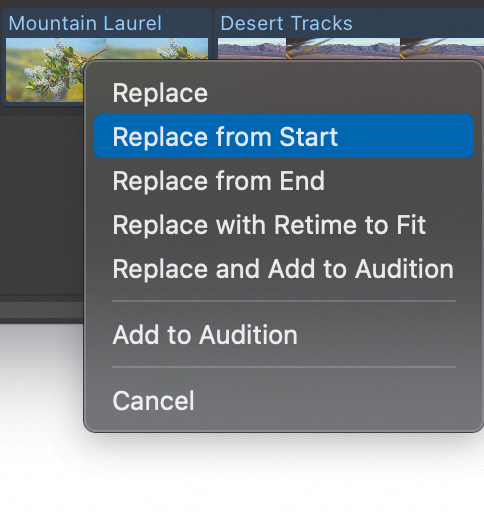
FIGURE 4.9 The five options for a replace edit. Drag a Browser clip on top of a timeline clip to display this list.
Replace. This replaces the timeline clip with the Browser clip and uses the duration of the Browser clip (shortcut: Shift+R).
Replace from Start. This replaces the timeline clip with the Browser clip and uses the duration of the timeline clip (shortcut: Option+R).
Replace from End. This replaces the timeline clip with the Browser clip by editing the Out of the Browser clip to the Out of the timeline clip, then using the duration of the timeline clip to set the In of the Browser clip. This is basically a back-time edit, except it replaces the timeline clip. (A shortcut is available, but not assigned to a key.)
Replace with Retime to Fit. This is discussed in Tip 210, When to Use Replace with Retime to Fit.
Replace and Add to Audition. This is discussed in Chapter 5, “Advanced Editing.” See Tip 244, Create Auditions in the Timeline.
209 Use a Replace Edit to Replace Audio
Find and fix missing audio in less than a second.
You edited a clip into your project yesterday only to realize that you accidentally deleted the audio. Suddenly you really, really need that audio today. In this case, Undo won’t work. The mistake happened too long ago. Replace edit to the rescue.
A replace edit is a blindingly fast way to replace accidentally deleted audio.
Here’s a fast way to fix the missing audio problem:
Put the playhead (skimmer) anywhere in the timeline clip you want to fix. Don’t even select the clip.
Press Shift+F.
This creates a match frame of the timeline clip in the Browser.
Press Shift+1.
This makes sure you are editing both audio and video into the timeline.
Once you press Shift+1, you don’t need to press it again. Final Cut leaves this setting unchanged from one edit to the next.
Press Option+R.
This replaces the timeline clip with the clip in the Browser, but matches the duration of the Timeline clip.
You can replace missing audio in less than half a second!
210 When to Use Replace with Retime to Fit
Fit-to-fill edits always change the speed of the incoming clip.
A variation on the replace edit is the Replace with Retime to Fit option, also called a fit-to-fill edit. This is used to create a speed effect or if the B-roll clip is too short to fill the timeline clip. This is similar to the Replace from Start option, but it requires a duration for the Browser clip. Unlike the three replace edits discussed in Tip 208, Replace Edits Replace a Timeline Clip, this changes the speed of the Browser clip so that the duration of the new clip matches the duration of the original timeline clip.
Set an In and Out for the Browser clip you want to use. The duration is important.
Drag the Browser clip on top of the timeline clip you want to replace; see FIGURE 4.10. (A shortcut is available, but not assigned to any key.)

FIGURE 4.10 Drag a Browser clip on top of a timeline clip to reveal this menu.
In the menu, select Replace with Retime to Fit.
Final Cut changes the speed of the Browser clip to precisely match the duration of the timeline clip. The Retime to Fit option always changes the new clip’s speed.
211 Markers
Markers are the yellow sticky notes of video editing.
I love markers; see FIGURE 4.11. These cheerful little flags scattered throughout a project serve as navigational beacons, a list of tasks to do or that are done, even chapter markers for QuickTime movies and DVDs. Whether you create markers in the timeline or Browser, the process is the same.
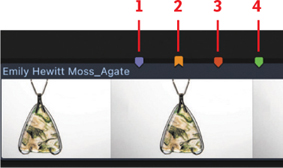
FIGURE 4.11 The four marker types: 1. Marker, 2. Chapter, 3. To-do, 4. Completed to-do. (Jewelry image ©2022 EmilyHewittPhotography.com)
To create a marker, put the playhead (skimmer) where you want it, and press M.
To modify a marker, double-click the marker icon to open the Marker dialog.
To move a marker, right-click it and choose Edit > Cut. Move the playhead (skimmer) to the new location, and choose Edit > Paste.
Or—place the playhead (skimmer) on the marker and press Control+, [comma] or . [period] to move the marker left or right one frame at a time.
To jump the playhead to a marker, press Control+; [semicolon] or Control+’ [apostrophe].
To delete a marker, either double-click it and click the Delete button in the Marker dialog or right-click it and select Delete from the menu.
When you modify a marker, the Marker dialog appears; see FIGURE 4.12.

FIGURE 4.12 The Marker dialog. The top buttons create a: 1. Marker, 2. To-do marker, and 3. Chapter marker. (Jewelry image ©2022 EmilyHewitt Photography.com)
212 Create Chapter Markers
Chapter markers are great for QuickTime navigation, not just DVDs.
Note
Although Final Cut supports picking a chapter poster frame, QuickTime Player ignores it. Instead, it displays the frame under the marker.
I use chapter markers in many of my QuickTime and MP4 movies; see Figure 4.12. They create little navigational thumbnails used in QuickTime Player, and other video players, to jump to a specific scene in a movie. You don’t need to create DVDs to use chapter markers.
If a marker already exists, double-click it to open the Marker dialog box.
Otherwise, put the playhead (skimmer) where you want it, and press M.
Press M a second time to open the Marker dialog box.
Click the far-right icon (3 in Figure 4.12) to create a chapter marker.
Chapter markers generally display a poster frame in the video player. That round orange dot (see FIGURE 4.13) selects the frame used for the poster frame. It is located 16 frames after the marker to avoid displaying the middle of a dissolve as the poster frame. To choose a different frame, drag the round dot to the frame you want to use, which need not be in the same clip.

FIGURE 4.13 The orange marker is a chapter marker. The round orange dot selects the poster frame for that marker. Drag the dot to change the frame. (Jewelry image ©2022 EmilyHewittPhotography.com)
213 Gaps and Timeline Placeholders
Gaps and placeholders have a variety of uses.
A gap is a clip that is opaque and solid black, with a default duration of two seconds, though the duration can vary as much as you want. I use gaps to separate scenes, to add a short pause, or simply as an indicator that something is missing. To add a gap, choose Edit > Insert Generator > Gap (shortcut: Option+W). This inserts a two-second gap clip at the position of the playhead (skimmer). You can adjust the duration of a gap the same as any other clip.
Placeholders are similar to gaps in that they are variable duration clips edited into the timeline but used to simulate missing shots. The content of the placeholder is adjusted in the Inspector.
To add a new placeholder, choose Edit > Insert Generator > Placeholder (shortcut: Option+Cmd+W).
To modify an existing timeline placeholder, select the clip in the timeline. Click the Generator icon (red arrow) at the top of the Inspector; see FIGURE 4.14. In the panel that appears, select the objects you want to appear in the placeholder.

FIGURE 4.14 Placeholder content options in the Generator Inspector.
214 Find Duplicated Media
This is a fast way to find shots used more than once.
Apple recently added a feature that quickly finds duplicated media in a project. Apple calls these duplicated ranges. This feature is off by default. To display media used more than once in a project:
Open the Clip Appearance button in the top-right corner of the timeline (see FIGURE 4.15), and select the Duplicate Ranges checkbox.
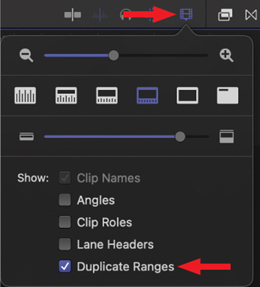
FIGURE 4.15 Display duplicated media using the Clip Appearance menu.
Clips that use the same media are flagged in the timeline with hash marks at the top of the clip; see FIGURE 4.16.

FIGURE 4.16 Clips that share the same media are indicated with hash marks (above).
Open the Timeline Index, click the chevron (red arrow), and choose Show Clips with Duplicated Ranges; see FIGURE 4.17.
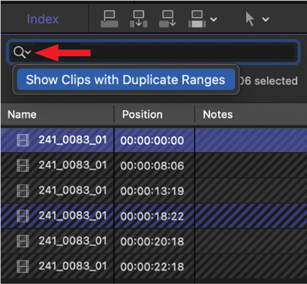
FIGURE 4.17 The Timeline Index shows clips that share media. When you select a clip, other clips sharing its media are highlighted in blue (right).
Selecting a clip in the Timeline Index selects it in the timeline and moves the playhead to the In of that clip.
Editing Tools
Editing tools are used to select, modify, trim, or move timeline clips.
215 The Tools Palette
These are the tools you’ll need for editing and trimming.
This toolset, like most, is hidden. Click the arrow icon with the chevron at the top of the timeline to reveal it; see FIGURE 4.18.
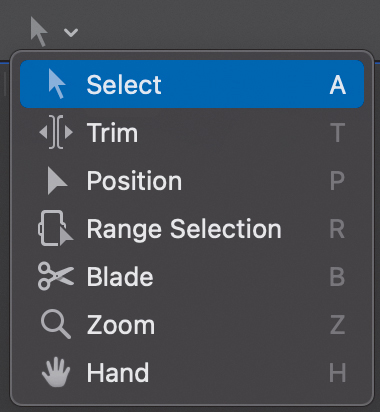
FIGURE 4.18 Click the chevron to reveal the timeline Tools palette.
Select (shortcut: A). (We often call this the Arrow tool.) A general-purpose tool for moving and selecting stuff.
Trim (shortcut: T). Used for roll and slip trimming.
Position (shortcut: P). Turns off the magnetic timeline to move clips independently.
Range Selection (shortcut: R). Sets an In and/or Out range in the timeline or Browser. This is a specialized form of the Select tool.
Blade (shortcut: B). Cuts clips.
Zoom (shortcut: Z). Zooms in to or out of the timeline.
Hand (shortcut: H). Moves the timeline without moving any clips.
216 The Power of the Position Tool
The Position tool disables the magnetic timeline.
The Position tool (shortcut: P), see FIGURE 4.19, moves any clip anywhere, even leaving gaps, by disabling the magnetic properties of the timeline. Essentially, when the Position tool is active, Final Cut edits like every other nonlinear editor.

FIGURE 4.19 The Position tool overrides the magnetic timeline.
When you drag a clip, the clip doesn’t spring back. Instead, a clip of black video, called a gap, is inserted between the end of the previous clip and the one you are moving.
When you trim clips, it leaves a gap.
When you drag one clip on top of another, the edge of the new clip overwrites the old clip.
When you move a clip, any open space created is filled with a gap.
The Position tool provides a choice on how our clips behave when we move them; enabling the magnetic timeline or turning it off.
217 The Range Tool Doesn’t Select Anything
The Range tool sets an In and Out in the timeline or Browser.
The Range tool (shortcut: R), see FIGURE 4.20, is a specialized form of the Select tool. All it does is set an In and Out in the timeline or Browser. Select the Range tool from the Tools palette.

FIGURE 4.20 The Range tool sets Ins and Outs.
The Range tool is used in the Browser but, more commonly, in the timeline. (The timeline allows only one In and Out at a time.) While you can use I and O to set the In and Out, the Range tool is simpler—you just drag.
An In and Out is not the same as a selection. Timeline ranges are as small as a few frames in the middle of a clip or span multiple clips. Ranges generally don’t end at the edges of a clip, though they can; see FIGURE 4.21. Ranges are used for the following:
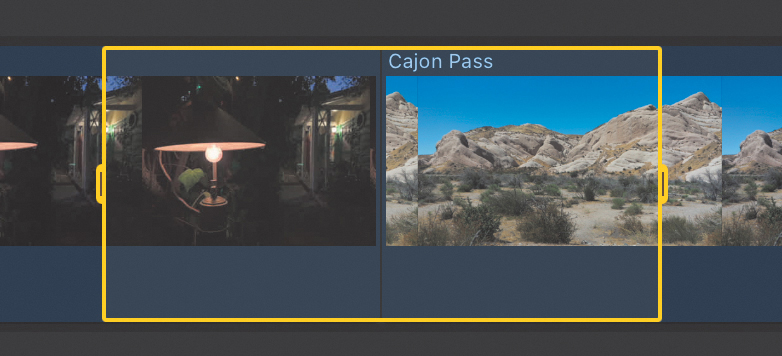
FIGURE 4.21 A timeline range spanning two clips. Note the adjustment handles on the In and Out.
Exporting a portion of the timeline
Adjusting audio levels within the range
Adjusting keyframes within the range
Creating three-point and back-time edits
Deleting portions of a clip, or a section of the timeline that doesn’t include entire clips
To remove a range selection, click outside the yellow range bounding box with the Arrow tool.
218 Cut Clips with the Blade Tool
Both the Blade tool and shortcuts work, but they work differently.
The Blade tool (shortcut: B), see FIGURE 4.22, cuts clips. So does Cmd+B. But they cut clips differently.
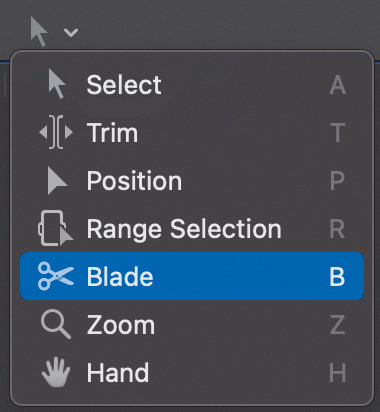
FIGURE 4.22 The Blade tool cuts clips.
Select the Blade tool from the Tools palette. The Blade tool cuts single clips anywhere, whether the clip is selected or not. If you press Shift, the Blade tool cuts all clips—including captions—where you click.
Cmd+B cuts one or more clips but only at the position of the playhead (skimmer).
If no clips are selected, Cmd+B cuts the Primary Storyline clip.
If some or all clips are selected, it cuts only selected clips.
If a selected clip is disabled (V), it cuts the clip anyway.
The Blade tool is more flexible in terms of where it cuts. Cmd+B is more efficient and selective by cutting only selected clips at the position of the playhead (skimmer).
219 The Zoom Tool
This is a faster way to change the scale of the timeline.
The Zoom tool (shortcut: Z), see FIGURE 4.23, changes the scale of the timeline, without affecting any clips.
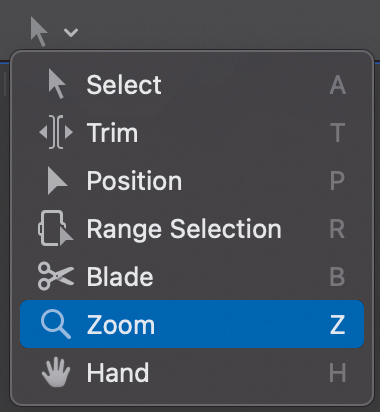
FIGURE 4.23 The Zoom tool scales the timeline.
To zoom in, select the Zoom tool and click in the timeline.
To zoom in to a specific section of the timeline, drag the Zoom tool over the area you want to view.
To zoom out, Option-click the Zoom tool in the timeline.
With another tool selected, press and hold Z, then click or drag to resize the timeline. Final Cut zooms in; then, when you let go of Z, it selects the previous tool.
220 The Hand Tool
The Hand tool is a mover.
The Hand tool (shortcut: H), see FIGURE 4.24, moves the timeline without moving anything in the timeline. It’s the only tool that can’t select or modify a clip in some way.

FIGURE 4.24 The Hand tool moves the timeline without moving clips.
Select the Hand tool from the Tools palette.
Drag it in the timeline.
The timeline moves, but the clips don’t.
Even faster:
Press and hold H.
Drag to where you want to go, then let go.
Final Cut switches back to the previous tool.
221 The (Hidden) Delete Key
This is especially helpful for laptop keyboards.
Full-size keyboards have two delete keys: the big one labeled Delete and the small one labeled Del. The big one deletes text to the left; the small one deletes text to the right.
But what if you are using a laptop? The Del key doesn’t exist. That’s where the hidden Delete key comes in; see FIGURE 4.25.
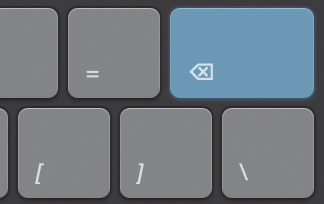
FIGURE 4.25 The dual-purpose Delete key on a laptop keyboard.
Press the Delete key to delete text to the left, as always.
Press Fn+Delete to delete text to the right.
I use this all the time.
222 The Timeline Clip Menu
Just like the Browser and Viewer, the Timeline has a hidden menu.
Right-click any timeline clip to reveal its hidden (contextual) menu; see FIGURE 4.26. Most of these options involve editing or trimming. We’ll cover them in other tips.

FIGURE 4.26 Right-click any timeline clip to reveal this contextual menu.
Trim Clips
Trimming adjusts where two clips touch. Editing builds the story. Trimming makes it perfect. You’ll spend far more time trimming than editing; it’s that important.
223 Trimming Basics
Here’s how to trim an edit point.
An edit point is where two clips touch. It has three sides: the Out of the outgoing clip, the In of the incoming clip, and both the In and the Out.
To trim an edit point, do one of the following:
Select the Arrow (Select) tool (shortcut: A) and drag either the Out or the In; see FIGURE 4.27. This is a ripple trim; because it adjusts one side of the edit, its effect ripples through the rest of the timeline.

FIGURE 4.27 Trim the Out of the outgoing clip by dragging with the Arrow tool.
Select the Trim tool (shortcut: T) and drag both the Out and In at the edit point. This is called a roll trim; because it adjusts both sides of the edit, it rolls the edit point to a new location.
As you drag, the numbers above the edit point indicate current timecode (left) and the amount the selected frame or edit point moves during the trim. In addition to dragging, there are several keyboard shortcuts you can use to trim. Put the playhead (skimmer) at the edit point you want to adjust and do the following:
Press left square bracket to select the Out.
Press right square bracket to select the In.
Press backslash [] to select both the In and the Out.
Press comma [,] to move the selected edit point one frame left.
Press period [.] to move the selected edit point one frame right.
Press Shift+, to move the selected edit point ten frames left.
Press Shift+. to move the selected edit point ten frames right.
With an edit point selected in the timeline:
Press + [plus] to switch the timecode display into data-entry mode and tell FCP you intend to move the selection to the right.
Or—press – [minus] to switch the timecode display into data-entry mode and tell FCP you intend to move the selection to the left.
Enter the number of seconds and/or frames you want the selected object to move.
Press Return to apply the shift.
As long as a selected edit point has sufficient handles and is not blocked by another nonselected clip, it will instantly move. For example:
Type +16 then press Return to move the selection 16 frames to the right.
Type –8 then press Return to move the selection 8 frames to the left.
224 Handles Are Essential for Trimming
Handles are extra video at the ends of a clip.
Handles are extra media before the In or after the Out. They are essential for trimming and transitions, because if you need to move the In earlier or the Out later, you need extra media to do so.
Final Cut alerts you whether the end of a clip (either In or Out) has handles; see FIGURE 4.28. If the selected end of a clip is yellow, there are additional frames beyond the edit point. If the edge is red, that is the end of the clip.
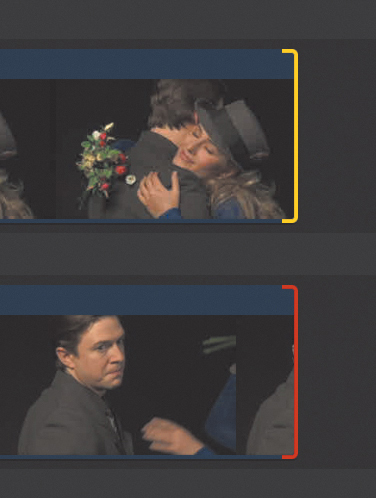
FIGURE 4.28 A red bracket means no handles. A yellow bracket indicates handles.
225 Trim the Top and Tail of a Clip
Sometimes you just need something quick and dirty.
If the deadline were any closer, it would be sitting in your lap. All you need is to trim the beginning and end of a timeline clip and export it. There’s no time to drag anything. For greatest speed, use the skimmer to hover over the trim point. Don’t click anything.
The whole process takes mere seconds from trim to export with exporting happening in the background. TABLE 4.1 lists these shortcuts.
TABLE 4.1 Top and tail trimming shortcuts
SHORTCUT | WHAT IT DOES |
|---|---|
Option+[ | Trim the start of a clip to the playhead (skimmer). |
Option+] | Trim the end of a clip to the playhead (skimmer). |
Option+ | Trim the clip to the selected range. (This requires using the Range tool to set a range.) |
Cmd+E | Export the clip to the default destination. |
226 The Hidden Precision Editor
The Precision Editor is an incredible teaching tool.
If editing and trimming are new to you, the Precision Editor is an interactive way to learn and develop your trimming skills. To open it, double-click any edit point; see FIGURE 4.29. The edit point opens with the outgoing clip on top.
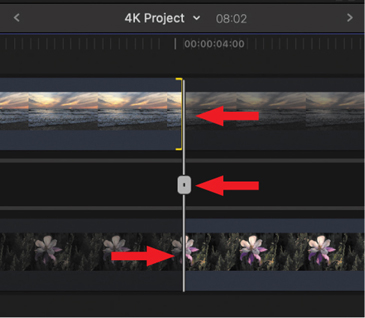
FIGURE 4.29 The Precision Editor. The Out is selected in the top layer.
To adjust the Out, drag the top edit point (top arrow). This creates a ripple trim.
To adjust the In, drag the bottom edit point (bottom arrow). This, too, creates a ripple trim.
To adjust both the In and the Out, drag the gray box control between the layers (middle arrow). This creates a roll edit.
The darker areas at the end of each clip indicate the amount of handles, or extra video, before the In or after the Out.
A selected clip edge that’s yellow means the clip has handles. A red edge means no handles.
To exit the Precision Editor, press Esc, or double-click the middle roll trim icon (middle arrow).
This is a great teaching tool to learn what happens during a trim and the importance of handles for effective trimming.
227 The Trim Edit Window
Provides feedback on what you are doing in the timeline.
The Trim Edit window appears only if you enable Preferences > Editing > Show detailed trimming feedback; see FIGURE 4.30.

FIGURE 4.30 Preferences > Playback.
When you grab the edge of a clip with either the Select (Arrow) or Trim tool and drag, the Trim Edit window appears; see FIGURE 4.31.
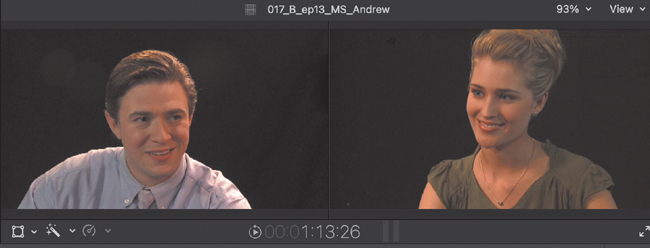
FIGURE 4.31 The Trim Edit window. The Out is on the left; the In is on the right.
The left side of the window shows the Out at the edit point. The right window shows the In at the edit point. As you drag the selected portion of the edit point, this window shows what’s changing.
If “Show detailed trimming feedback” is not selected in Editing > Preferences, Final Cut displays only the frame you are adjusting. I prefer seeing both windows, which is why I turn this preference on. It is much easier to trim using the Trim Edit window. (See Tip 70, Optimize Editing Preferences.)
228 A Super-Fast Trimming Shortcut
This keyboard shortcut is a high-speed trimming tool.
Shift+X is the fastest way to move a selected edit point.
Sometimes, you just want to move the selected edit point somewhere else. Quickly.
Select the side of the edit point you want to move.
Position the playhead (skimmer) where you want it to go.
Press Shift+X.
This technique is called an extend edit. The selected edit point jumps to the playhead, provided there are sufficient handles on the clip you are trimming and that the move is not blocked by another clip. I use this all the time for adjusting title durations, roll trims, and adjustment layers.
229 Split Edits: The Workhorse of Editing
Split edit: When audio and video edit points occur at different times.
Without question, to me, the most important trim is a split edit; see FIGURE 4.32. This is where the audio and video edit points occur at different times. Split edits are generally created in the Primary Storyline.

FIGURE 4.32 A split edit with the audio edit rolled to the right of the video edit.
Tip 305, Split Trims Edit Audio Separately, shows how to do this in detail. I mention it here because it is relevant to editing and trimming.
230 Enable Clip Skimming
Clip skimming is a fast way to review a timeline clip.
Turn skimming off (S). Put the cursor inside a timeline clip, and drag. Nothing happens.
Press Option+Cmd+S. Now drag the cursor inside a timeline clip. See how quickly you can see the contents of that timeline clip in the Viewer?
Why would you do this? Imagine you have multiple clips stacked vertically with an effect that blocks most of those clips (a very typical effect, by the way). Clip skimming displays a clip even if it is blocked by another clip on a higher layer.
There’s no need to use this technique if you have only one layer of timeline clips.
231 How to Use Audio Clip Skimming
Clip skimming enables audio review in high speed.
You first met skimming in Chapter 2, “The Final Cut Pro Interface.” Audio clip skimming is a special form of clip skimming. It’s a fast way to review a single audio clip, without hearing any other audio clips above or below it. It lets you zero in on the sound from a specific clip.
Choose View > Clip Skimming.
Or—press Shift+S.
Drag the cursor across the clip in the timeline you want to hear.
Repeat the same keystrokes to turn clip skimming off.
232 A Slip Trim Optimizes B-Roll
Slip trim: Adjust content without changing location or duration.
Another hidden trimming tool that I can’t live without is the Slip tool. This tool adjusts the content of a shot, moving it earlier or later, without altering the clip location in the timeline or the clip duration. It’s like a window in a wall. You can’t change the size or position of the window, but by shifting your position, you can change the view.
Slip trims adjust clip content without changing its location or duration.
Select the Trim tool (shortcut: T).
Click in the middle of the clip you want to adjust.
Drag left or right.
The Trim Edit window opens up and displays the In of the slipping clip on the left and the Out on the right.
I use this constantly to find the best piece of B-roll that fits a precise duration and location.
I set the timing of a clip during the edit. I adjust the content once it’s in the timeline using a slip trim until I find the content that works best for my story.
The Timeline Index
The Timeline Index is unique to Final Cut. It tracks and organizes all elements in the timeline in searchable lists.
233 The Timeline Index
This is a powerful tool for navigation and organization.
The Timeline Index is unique to Final Cut and a highly powerful tool to organize all the elements in the timeline. Apple describes it as a list-based view of the timeline. I use it constantly to view clips, markers, keywords, titles, and roles, as well as select clips and navigate the timeline. As you play a project, the playhead in the timeline and the horizontal playhead in the Index move in sync.
To open the Index (see FIGURE 4.33), do either of the following:
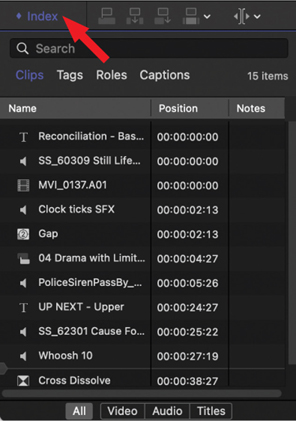
FIGURE 4.33 The Timeline Index. Click the word “Index” to open.
Click the Index button in the upper left of the timeline.
Press Shift+Cmd+2.
Here’s what you can do in the Timeline Index:
View a list of all clips in the currently open project, sorted chronologically.
Click any clip name, or other element, to jump the playhead to it and display it in the Viewer.
Select one or more clips or other elements in the timeline.
Rename a clip—select it, enter a new name, and press Return.
Search for a clip, title, marker, or other timeline element—by name or a portion of its name.
Delete an element to delete it in the timeline.
View and add notes. (However, I find it easier to select the clip, then add the note in the Info Inspector; see Tip 171, Add Notes to One or More Clips.)
View active multicam angles.
View, reassign, and edit roles.
234 Timeline Index: Customization
Modify columns in the Timeline Index like the Browser.
The Timeline Index organizes all the elements in the timeline into a list, just like a spreadsheet.
To change column widths, drag the dividing lines between column headers.
To move columns, drag and rearrange column headers.
To reveal more columns, right-click a column; see FIGURE 4.34.

FIGURE 4.34 Right-click a column header to reveal hidden Timeline Index columns.
This feature is not available for the Roles tab, which doesn’t use columns.
235 Timeline Index: Navigation
The Timeline Index is faster than scrolling through the timeline.
The Timeline Index is built for speed and organization. It is a fast way to find a clip—audio, video or title—for example, to check spelling or apply an effect.
In FIGURE 4.35, if you look closely along the left edge, you’ll see a faint playhead (the red arrow points to it). This echoes the movement of the timeline playhead, because the Timeline Index is simply the timeline itself, recast as a list.
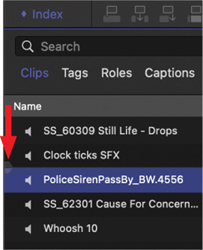
FIGURE 4.35 Click any line of text to move the playhead to that element and select it.
To locate an element, enter text in the search box.
To jump to and select a clip, click any line of text.
To select a range of clips, Shift-click more than one line of text.
To select any clips you click, Cmd-click more than one line of text.
To delete clips, select a line, or a group of lines, and press Delete.
Once something is selected, it is easy to add an effect, move the group, or delete it.
236 Timeline Index: Clips
Find, sort, rename, and navigate clips.
Open the Timeline Index and click Clips; see FIGURE 4.36.
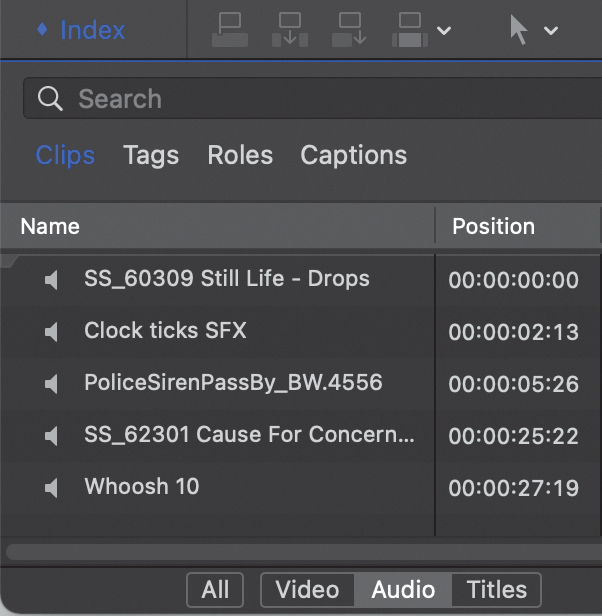
FIGURE 4.36 The Clips panel in the Timeline Index with audio clips selected.
At the bottom, choose to view all clips or filter them into Video, Audio, or Titles.
I find the Titles option very helpful at the end of a project. I can quickly jump from one title to the next to verify format and spelling. This high-speed review is far faster than scrolling through the timeline and hoping that I spot them all.
237 Timeline Index: Tags
This is the most useful section of the Timeline Index.
The Tags portion of the Timeline Index (see FIGURE 4.37) is the most useful to me. (Roles are second.) This displays all markers and keywords. The following numbered list corresponds to the number callouts in Figure 4.37:
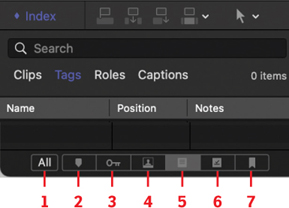
FIGURE 4.37 1. All tags, 2. Blue markers, 3. Keywords, 4. Analysis keywords, 5. To-do markers, 6. Completed markers, and 7. Chapter markers.
All tags
All standard (blue) markers
All keywords
All keywords created though analysis (for example, Find People)
To-do markers
Completed To-do markers
Chapter markers
All my videos include chapter markers for navigation. Similar to titles, I use this panel to find and review each marker before final export. Also, in Tip 240, Timeline Index: Markers, I’ll show how to use to-do markers to create an editing checklist for your project.
238 Timeline Index: Roles
Roles are incredibly useful for audio, but they are not easy to understand.
When Apple introduced roles to Final Cut, I found them intimidating and alien. But in the years since, I spent time learning how to use them, and now, they are part of almost all my projects. The Timeline Index simplifies using roles; see FIGURE 4.38. Chapter 6, “Audio,” provides details on how to use roles.

FIGURE 4.38 The Roles panel in the Timeline Index.
As an example, I use roles every week when editing my webinars. I do the edit in Final Cut, then send the audio to Adobe Audition for audio cleanup and sweetening. That mixed audio is exported as a stereo pair and imported back into Final Cut with a Final Mix role assigned to it. Using this section of the Timeline Index, I can disable all dialogue and effects clips and enable the final mix with one mouse click. No messing with layers or individual clips. Works great.
239 Timeline Index: Captions
Use the Timeline Index to find and edit captions.
The Timeline Index is extremely useful when finding and reviewing every caption in a project; see FIGURE 4.39. In operation, it works the same as the Clips panel.

FIGURE 4.39 The Caption panel in the Timeline Index.
What I really like about this panel, though, is the ability to double-click a caption to open it for editing in the timeline. This is something you can’t do for titles, though you can do it for markers. However, you can’t use the Timeline Index to change the timing of a caption. Caption durations are changed only in the timeline.
240 Timeline Index: Markers
Here are some additional tricks you can do with markers.
Although you can’t copy and paste markers from the Timeline Index (see FIGURE 4.40), here are some things you can do:

FIGURE 4.40 Four different markers and their icons (top to bottom): Chapter, Standard, To-Do, and Completed To-Do. Note the horizontal playhead below Scene 2.
Select one or more markers and delete them.
Display markers by category: Chapter, Standard, To-do, and Completed.
Double-click a marker to open it for editing.
Add a note to a marker, which is different from its text.
You can even build an editing checklist in the timeline, then display it in the Timeline Index; see FIGURE 4.41. To see To-dos, click the icon indicated by the left red arrow. Click the icon to the right of it to see all completed To-dos.
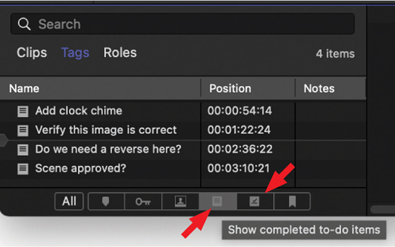
FIGURE 4.41 Use the Timeline Index to build a To-do List. Select between To-do (left arrow) or completed To-do items (right arrow).
Click the icon to the left of a To-Do marker in the Timeline Index to mark it as completed.
Chapter 4—Basic Editing Shortcuts
CATEGORY | SHORTCUT | WHAT IT DOES |
|---|---|---|
Marking | I Shift+I Option+I O Shift+O Option+O X Option+X | Set an In at the playhead (skimmer) Jump playhead to the In Delete the In Set an Out at the playhead (skimmer) Jump playhead to the Out Delete the Out Set In and Out for entire clip Delete both In and Out |
Editing | E W D Q Cmd+V Option+V Option+Cmd+Up arrow Option+Cmd+Down arrow Cmd+G Shift+R Option+R Option+W Cmd+B M Option+M Control+[Comma/Period] | Append selected clip to end of timeline Insert selected clip at playhead (skimmer) Overwrite selected clip at playhead (skimmer) Edit selected clip at playhead (skimmer) on higher layer Paste clip into Primary Storyline at playhead (skimmer) Paste clip into layer above Primary Storyline at playhead (skimmer) Lift the selected clip in the Primary Storyline to a higher layer Overwrite selected connected clip into Primary Storyline Consolidate upper layer clips into a connected storyline Replace timeline clip with Browser clip, use Browser clip duration Replace timeline clip with Browser clip, use timeline clip duration Insert gap at playhead Cut selected clip(s) at playhead (skimmer), does not cut captions unless they are selected Add marker Add marker and open marker dialog Move marker under playhead (skimmer) left/right one frame |
Trimming | Shift+X [ - ] - [Comma/Period] Shift+[Comma/Period] Shift+drag Shift+Blade tool | Extend Edit to position of playhead Select left, right, or both edit points for trimming Move selected edit point or clip left/right one frame Move selected edit point or clip left/right ten frames Constrain the movement, when dragging a timeline clip, to up or down only Cut all timeline clips, including captions, at the position you click |
Selection & Navigation | S N V Shift+Cmd+2 Control+; / ‘ Cmd+Up arrow Cmd+Down arrow | Toggle skimming on/off Toggle snapping on/off Toggle clip visibility on/off Display/Hide Timeline Index Jump playhead to previous/next marker Select clip on next higher layer in timeline Select clip on next lower layer in timeline |
Chapter Wrap
Well, that was intense. This chapter covered the basics of editing and trimming. In the next chapter, we’ll head into weeds looking at advanced editing and trimming techniques in Final Cut Pro.
